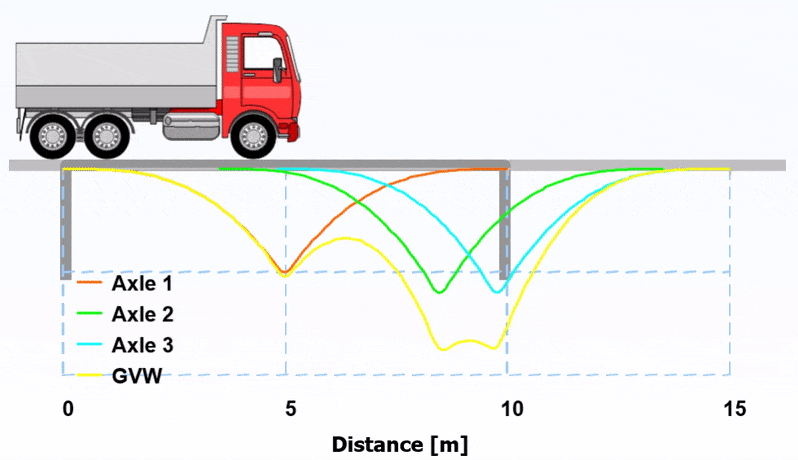Bridge Weigh-in-Motion
Principle
The principle of Bridge Weigh-in-Motion (B-WIM) was first stated by Ghosn in the United States in the 1970s: for this purpose, the deformations of a bridge are measured and by inverse modeling, the axle weights and distances between axles are reconstructed.
For this, the principle of superimposition is used (Figure 1). Thus the measured effect is the effect of the different axles on the bridge. The effect of an axle is given by multiplying its weight with the appropriate influence line evaluated at the abscissa of the axle (convolution of the vertical loads and the influence function).
It should be noted that in the first systems installed, sensors on the surface (on the roadway) informed the system of the passage of a vehicle, and triggered the recording and inverse calculation. These sensors were called FADs (First Axle Detectors). Today all sensors are on/under the bridge (not on the roadway), it is "enough" to set a trigger threshold to detect the passage of a vehicle.
Measured effects
Any measurable effect can be used for instrumented bridge weighing. However, it is necessary that the sensors are not located at a node of the effect. In addition, it is preferable that the effect - or its numerical value - is sensitive to the passage of a truck, if possible to different axle weights (local effect).
The following were measured :
- Longitudinal bending deformations on single-span bridge,
- Longitudinal bending deformations on the underside of orthotropic slab troughs,
- Shear stress deformations.
Calibration
In measuring these effects, two categories of information are unknown: those related to the vehicle (number of axles, weight on axles, distance between axles) and those related to the structure (lines of influence).
In order to evaluate the line(s) of influence, a calibration is carried out with trucks of known weight and dimensions that are driven over the structure in a fairly large number of passes. This makes it possible to calibrate the lines of influence for the different sensors of the system.
Experiments carried out
Several instrumentations have been on the Millau Viaduct in 2010-2011 and 2016-20174.
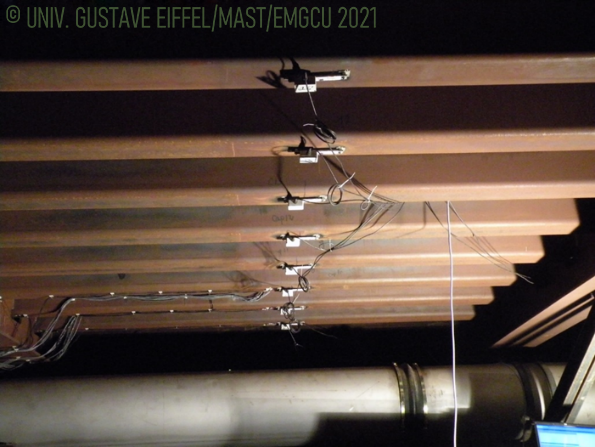

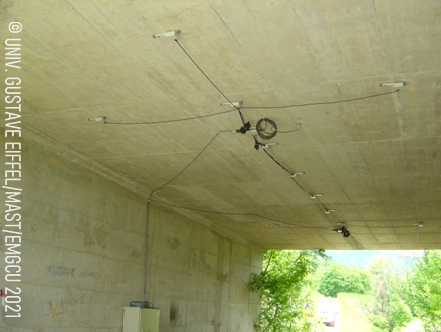
The bridge is not skew, which is an important criterion for good results. The results were very good, even if we only considered heavily loaded trucks5.
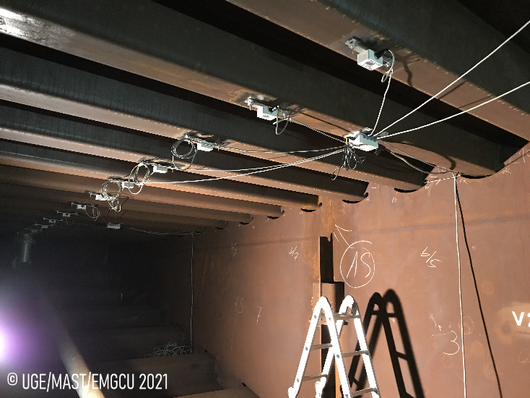
Université Gustave Eiffel/IFSTTAR and Cerema (Le Bourget Laboratory) instrumented the bridge in B-WIM to obtain the loads of the circulating trucks, and carried out fatigue life calculations of the various welds1,2,3.
The instrumentation itself is similar to the one of the Millau viaduct, but the results are totally different: for Normandy, the error was large (transfer of about 1 ton from the second axle to the first for the 5 axles).
The results were sufficient for a fatigue recalculation or for the detection of a large overload, but not for automated sanction control or for overloads of less than 2 tons.
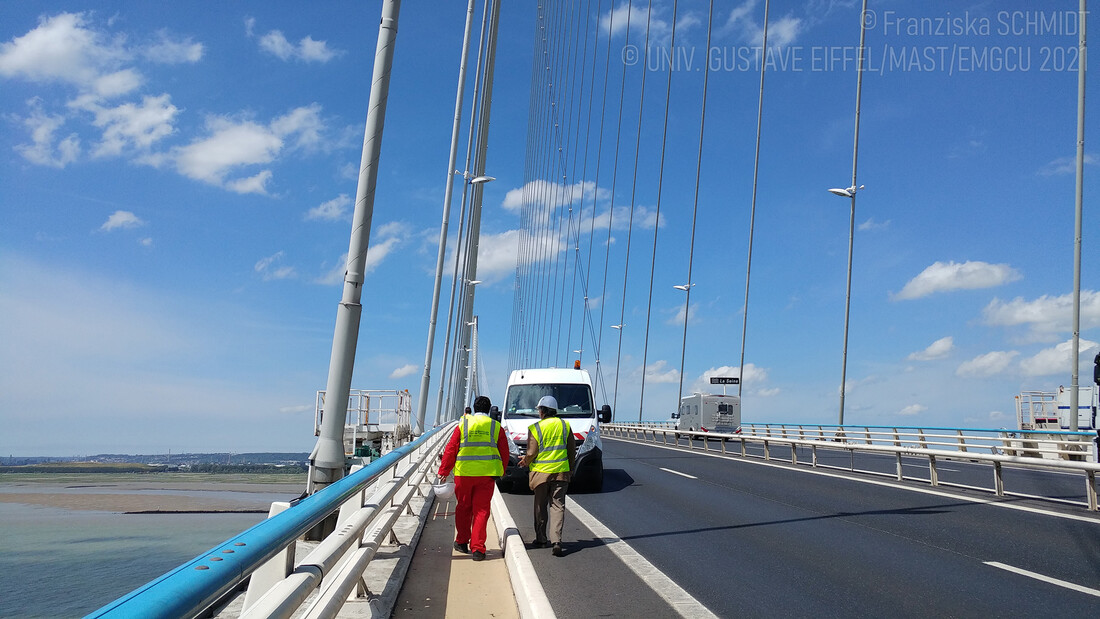
Conclusions - perspectives
There is still work to be done to make bridge weighing as accurate as some pavement sensor weighing methods. Nevertheless, it has the advantage of pursuing, with a single instrumentation, two objectives: the monitoring of the structure and the monitoring of rolling loads.
References
- JACOB, Bernard, SCHMIDT, Franziska, 2019, Assessment of bridge lifetime in fatigue against abnormal loads. Case of Normandy bridge, 26th World Road Congress (PIARC ), ABU DHABI, EMIRATS ARABES UNIS, 2019-10-06, 11 p. https://hal.archives-ouvertes.fr/hal-02466482/document
- JACOB, Bernard, SCHMIDT, Franziska, ARROYO CONTRERAS, Moisés, 2019, Fatigue assessment of Normandy bridge under traffic loading, ICWIM8, 8th International Conference on Weigh-In-Motion , PRAGUE, TCHÈQUE, RÉPUBLIQUE, 2019-05-20, 10 p. https://hal.archives-ouvertes.fr/hal-02465106/document
- ARROYO CONTRERAS, Moisés, JACOB, Bernard, SCHMIDT, Franziska, 2019, Assessment in fatigue of an orthotropic steel deck bridge under traffic loads and impact of abnormal loads. Case of Normandy bridge, TRB, Transportation Research Board Annual Meeting, WASHINGTON, ETATS-UNIS, 2019-01-13, 16 p. https://hal.archives-ouvertes.fr/hal-02464939/document
- SCHMIDT, Franziska, MAVRIC, M, ZNIDARIC, A, JACOB, Bernard, 2016, Use of B-WIM for Monitoring Traffic on a Specific Route on France, ICWIM7 - 7th International Conference on Weigh-In-Motion, FOZ DO IGUACU, BRESIL, 2016-11-07, International Society for Weigh-In-Motion, 7 p. https://hal.archives-ouvertes.fr/hal-01512631v1
- SCHMIDT, Franziska, MARTINET, Victor, JACOB, Bernard, 2016, Utilisation des ponts routiers pour le pesage et le contrôle des poids lourds, ATEC ITS France, Montrouge, FRANCE, 2016-01-26, 8 p. https://secure.key4events.com/key4register/schedule.aspx?e=419&dl=files%2Fpresentations%2F15731%2Fatec_its00072_bwim.pdf
Next topic : BIM Infra pour la maintenance/exploitation
